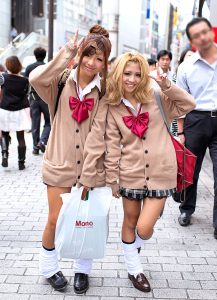
Appropriation and acculturation
By Brittney MacDonald, Life & Style Editor
For years, North American culture has had a huge impact on what is popular in Asian countries such as Japan, China, and Korea. We see this in what the Japanese define as “gal” style (popular in the ’90s, with a loyal but smaller following today), by the English language influence in popular music, and by the fluctuating beauty standards present within their societies, which often prize a more “Westernized” appearance—such as smaller, straighter noses, wider eyes, light coloured hair, paler eye colours, and various other trends that come and go.
What does this have to do with modern Western street style?
In the early 2000s we began to see an exchange of cultural influences as North America became enamoured with Asian culture. This began initially with Japan—but it has since spread out to a fascination with Asian cultures in general. In the early years, this evoked cries of appropriation—the act of taking elements from a minority culture, by a majority culture, without a full understanding of those elements’ cultural significance—which, in many cases, it was.
However, as knowledge of cultural appropriation rose, so did the backlash against it, and this exchange of influence in pop culture became more akin to acculturation—the natural melding of cultural influence that occurs when differing cultures have extended contact with one another. These two acts may sound similar, but they’re not. Appropriation is often exploitative and usually tends to be fueled by stereotypes, while acculturation is more so a joint fascination.
You can see the difference in Western reactions to two different Asian cultural elements, which we now take a look at. In 2004 Gwen Stefani released Love. Angel. Music. Baby. an album which, visually, pulled a lot of influence from the Harajuku district in Shibuya, Tokyo, Japan. This was largely seen as exploitive because she presented the album with four Japanese women who followed her around in silence, giggling on occasion. The portrayal presented a false image of an infantilized Eastern culture, which Stefani signaled her authority over—as the only one who was allowed to speak. Though I’m sure not intentionally demeaning, this rubbed a lot of people the wrong way due to the behaviour’s colonial nature.
More recently, there has been an influx of Netflix original anime—which Merriam-Webster defines as “a style of animation originating in Japan that is characterized by stark colorful graphics depicting vibrant characters in action-filled plots often with fantastic or futuristic themes”—despite the fact that, according to a Quartz study, the top binge-watching Netflix countries are Canada, the United States, and Denmark. An Asian country doesn’t even enter the list’s top 10. So why put all the effort into producing Netflix originals for a non-Asian audience? The answer is that Asian youth culture and Western youth culture are acculturated, meaning they hold some similar interests. We are starting to enjoy elements of their mainstream media, and vice-versa.
Again, you might be wondering: What does this have to do with modern street style? Well, there is a simple answer—but it will have to wait until next week. Just keep all this in mind.



